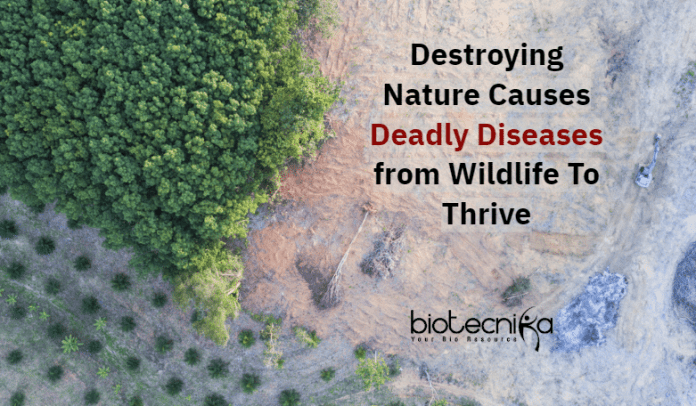Diseases Arise By Destroying Nature: New Study Analysis
A new study analysis shows that bats and rats host pandemic pathogens like Covid-19 increase in damaged ecosystems.
A comprehensive analysis work, published in the journal Nature, has found the numbers of rats, bats, and other animals that harbor diseases that can lead to pandemics such as Covid-19 increases due to the human destruction of natural ecosystems.
Around 7,000 animal communities on six continents were assessed in the research. It was found that larger species are often wiped out with the conversion of wild places into farmland or settlements. More adaptable and smaller creatures that can pass the most pathogens to humans, were found to benefit from the damage.
According to the assessment, it was found that the proportion of species that carry zoonotic disease pathogens increased by up to 70% compared within undamaged ecosystems and the populations of these zoonotic disease hosting animals were up to 2.5 times bigger in degraded places.
Diseases that originate in wild animals, such as the Nipah virus, Sars virus, and HIV are increasingly affecting the human populations. The UN and WHO have sent a series of warnings since the coronavirus pandemic began that the world must
tackle not just the health and economic symptoms, but also the destruction of nature, which is the cause of these outbreaks.Biodiversity experts said in April that more deadly disease outbreaks were likely unless nature was protected as the experts said in June that the Covid-19 pandemic was an “SOS signal for the human enterprise”.
The new analysis is the first to show that changes in animal populations that increase the risk of disease outbreaks are caused by the demolition of wild places, as the world’s population and consumption grows. The scientists said that their research demonstrates the need for ramping up disease surveillance and healthcare needs in those areas where nature is being ravaged.
A member of the research team from the ZSL Institute of Zoology in London, David Redding said, “People are inadvertently making it more likely for them to be in contact with an animal that carries disease when people on in and turn a forest into farmland. When deciding to convert natural ecosystems, the costs of disease were not being taken into account. That would cause a lot more money to be spent on treatments and hospitals.”
According to the estimations in a recent report, it was seen that just 2% of the Covid-19 crisis’s costs would be required to aid in preventing pandemics for a decade in the future.
In a commentary in Nature, Richard Ostfeld, at Felicia Keesing at Bard College, US, and the Cary Institute of Ecosystem Studies, US, said, “The world has been awakened about the threat that zoonotic diseases pose to humans through the Covid-19 pandemic.”
They added, “A widespread misperception that nature is the greatest source of the zoonotic disease has come with this recognition. This research provides an important correction that, in places where natural areas have been converted to urban areas, pastures, and croplands, that is where the greatest zoonotic threats arise. Striking patterns were detected by the researchers.”
Species such as rodents and bats being adaptable, mobile, small, and produce lots of offspring rapidly could probably be the reason for them to host the most pathogens and for simultaneously thriving in ecosystems damaged by humans.
Redding said, “The brown rat is the ultimate example.” These fast-living species invest relatively little in their immune systems as they have an evolutionary strategy that favors large numbers of offspring ahead of a high survival rate for each one. Ostfeld and Keesing said, “Compared to other creatures, the creatures that have rat-like life histories seem to be more tolerant of infections.”
Redding added, “An elephant, in contrast, has a calf every couple of years. It is born with a very strong and adaptive immune system as it has to make sure that offspring survives.”
Additionally, the analysis also found that small, perching birds that do well in habitats suffering from the impact of human activities were also disease hosts. Such birds can be reservoirs of diseases such as a type of chikungunya virus and West Nile virus.
More than half of the Earth’s habitable land has already been affected by humans. A member of the research team from the University College London, Prof Kate Jones said, “In those areas that are undergoing a lot of land disturbance, we should be strengthening disease surveillance and healthcare provision as they are increasingly likely to have animals that could be hosting harmful pathogens, given that the agricultural and urban lands are predicted to continue expanding in the coming decades.”
Source
Diseases Arise By Destroying Nature: New Study Analysis






























